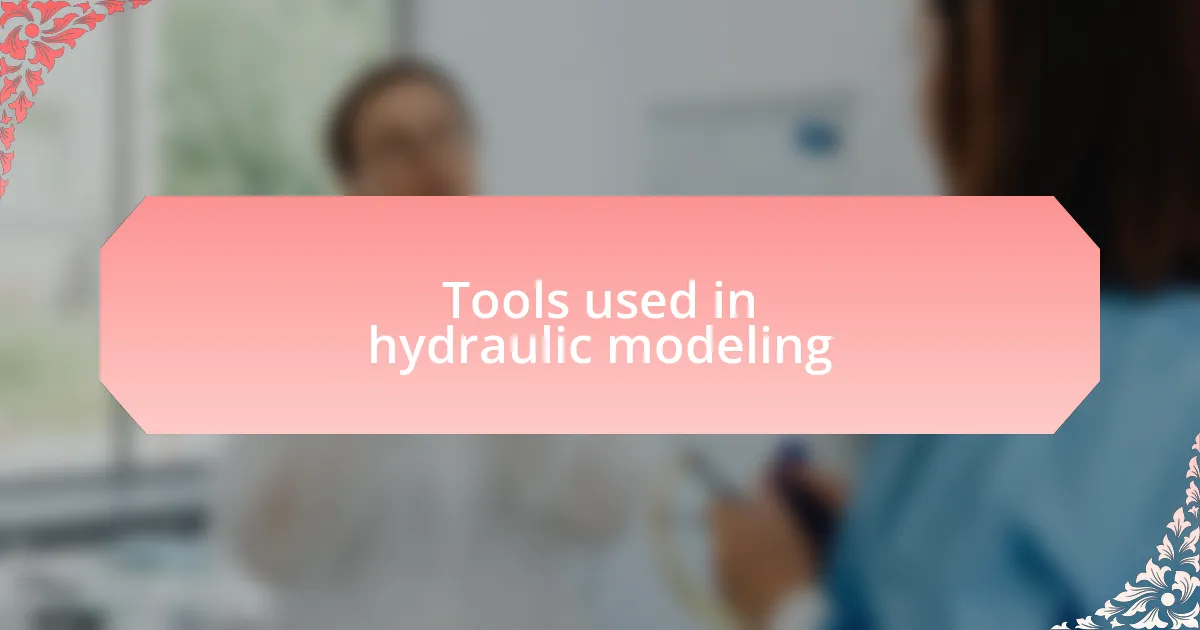Key takeaways:
- Hydraulic modeling blends art and science, crucial for safety and efficiency in hydro energy production.
- Software tools like HEC-RAS and physical modeling devices, such as flumes, enhance understanding of water flow dynamics.
- Iterative refinement and accurate data input are vital lessons learned; evolving models often reveal previously overlooked variables.
- Effective communication of model findings is essential for stakeholder collaboration and informed decision-making.

Understanding hydraulic modeling
Hydraulic modeling is a fascinating blend of art and science. I still remember the first time I sat down with a software program to simulate water flow in a river. It was almost like playing a video game, but with the weight of real-world consequences. How could a simple adjustment in parameters lead to such dramatic changes in flood predictions? That thought resonated deeply with me, revealing just how crucial accurate modeling is in ensuring safety and efficiency in hydro energy production.
At its core, hydraulic modeling involves creating a scaled representation of water behavior in specific environments. It’s not just about numbers; it’s about understanding the interactions of water with structures. For example, when I worked on a project modeling a dam, I got to see how varying inflow rates affected pressure on the dam’s face. It struck me how essential this knowledge is—not only for design purposes but also for future maintenance and safety measures.
Each simulation feels like a walk into the future—what risks can we foresee? Every model I’ve worked on has taught me the importance of precision. I often ask myself, how can we refine our approach to better capture the complexities of nature? By asking these questions, we deepen our understanding, leading to more sustainable practices in hydro energy generation.

Tools used in hydraulic modeling
When it comes to hydraulic modeling, software tools are critical. My go-to tool during my early projects was HEC-RAS, designed for simulating the flow of water through rivers and channels. I remember the sense of accomplishment I felt when I finally mastered the program’s nuances—getting accurate floodplain mapping right felt like solving a complex puzzle.
However, it wasn’t just about the software. Physical modeling tools, such as flumes and scaled-down models, also play a vital role. I once participated in a physical modeling project using a hydraulic flume, where we tested how different riverbed designs influenced flow patterns. Seeing water dynamics in real-time was enlightening and helped bridge the gap between theoretical predictions and actual behavior.
I’ve also come to appreciate the importance of data input tools like GIS (Geographic Information Systems) for hydraulic modeling. Integrating geographic data into my models allowed for a richer analysis of environmental impacts. I often reflect on how much more informed our decisions can be when we marry the power of tech with our understanding of hydrodynamics. Isn’t it amazing how these tools not only enhance our models but also expand our capacity to foresee and mitigate potential issues?

Key techniques in hydraulic modeling
One key technique I frequently utilized in hydraulic modeling is computational fluid dynamics (CFD). This method allowed me to visualize complex flow phenomena in a way that traditional methods could not. I remember a specific project where we simulated the interaction of water with structures, and I was amazed at how CFD revealed swirling vortices and pressure variations that dramatically influenced our design choices.
Another critical technique is the use of one-dimensional and two-dimensional modeling approaches. In my experience, 1D models were fantastic for preliminary assessments, particularly in river systems. However, I quickly learned that when it came to capturing the intricate flow of urban environments, 2D models were indispensable. That realization felt like a lightbulb moment—it was a reminder that the right model can make all the difference.
I can’t emphasize enough the role of sensitivity analysis in refining hydraulic models. By testing how different parameters affected model outcomes, I often uncovered unexpected insights. It was exhilarating to see how a slight change in boundary conditions could lead to drastically different water levels. This technique not only boosted my confidence in the models but also deepened my respect for the complexities of hydraulic systems. Have you ever had a similar experience where adjustments revealed hidden dynamics?

Lessons learned from hydraulic modeling
One of the most significant lessons I’ve learned from hydraulic modeling is the importance of iterative refinement. During a project where I was tasked with analyzing flood risks, I initially thought I had everything figured out. However, after several rounds of model adjustments and recalibrations, I realized I had overlooked some key variables. This taught me that modeling is not a one-and-done task; it’s an evolving process that often requires revisiting earlier assumptions. How often do we think we know what will happen, only to be surprised by the complexities we encounter?
Another crucial insight has been understanding the value of accurate data input. I once faced a situation where outdated topographical data skewed the model results drastically. Initially, I felt frustrated by the setback, but it highlighted how critical it is to base our models on reliable information. This experience reinforced my belief that good modeling begins with thorough data collection. Have you ever had a moment where you realized the foundation of your work was shaky? It can be humbling, but it’s also an invaluable lesson.
Moreover, I have come to appreciate the art of communication in hydraulic modeling. Early in my career, I tended to focus heavily on the technical aspects when presenting findings. However, I’ve learned that translating model results into accessible language for stakeholders can foster collaboration and better decision-making. It’s all about creating a narrative that connects the numbers to real-world implications. Don’t you think the effectiveness of our models diminishes if we can’t convey their significance clearly?